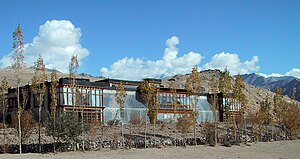Students' Educational and Cultural Movement of Ladakh: Difference between revisions
>GreenC bot (Rescued 1 archive link. Wayback Medic 2.5) |
imported>Wilhelm Tell DCCXLVI m (rmv: not relevant to SEMCOL) |
||
| Line 19: | Line 19: | ||
Built using simple, low-cost traditional techniques, the campus now comprises three residential houses, 20 small "cell rooms" and a large school building, all solar heated. Part of SECMOL's work is to develop techniques that use alternative energy sources. Ladakh has over 300 sunny days per year and the sun is therefore a reliable source of energy and an alternative to fossil fuels.<ref>[http://framtidsjorden.se/eng/index.php?option=com_content&task=view&id=419&Itemid=303 Future Earth]</ref> The campus is home to about 70 students and a few staff and volunteers, who live, work and study there. | Built using simple, low-cost traditional techniques, the campus now comprises three residential houses, 20 small "cell rooms" and a large school building, all solar heated. Part of SECMOL's work is to develop techniques that use alternative energy sources. Ladakh has over 300 sunny days per year and the sun is therefore a reliable source of energy and an alternative to fossil fuels.<ref>[http://framtidsjorden.se/eng/index.php?option=com_content&task=view&id=419&Itemid=303 Future Earth]</ref> The campus is home to about 70 students and a few staff and volunteers, who live, work and study there. | ||
The campus is maintained, and to a large degree run, by the students themselves on a democratic basis.<ref name="Official Website"/> | The campus is maintained, and to a large degree run, by the students themselves on a democratic basis.<ref name="Official Website"/> | ||
==Bibliography== | ==Bibliography== | ||
| Line 39: | Line 36: | ||
==External links== | ==External links== | ||
{{ | {{Commons category|SECMOL}} | ||
* [http://www.secmol.org/ Official website] | * [http://www.secmol.org/ Official website] | ||
*[https://web.archive.org/web/20110811132044/http://articles.timesofindia.indiatimes.com/2008-07-26/india/27939511_1_schools-education-system-village-education-committees The Times of India] | *[https://web.archive.org/web/20110811132044/http://articles.timesofindia.indiatimes.com/2008-07-26/india/27939511_1_schools-education-system-village-education-committees The Times of India] | ||
{{Authority control}} | |||
{{DEFAULTSORT:Students' Educational And Cultural Movement Of Ladakh}} | {{DEFAULTSORT:Students' Educational And Cultural Movement Of Ladakh}} | ||
[[Category:Education in Ladakh]] | [[Category:Education in Ladakh]] | ||
[[Category:Organisations based in Jammu and Kashmir]] | [[Category:Organisations based in Jammu and Kashmir]] | ||
[[Category:1988 establishments in Jammu and Kashmir | [[Category:1988 establishments in Jammu and Kashmir]] | ||
[[Category:Organizations established in 1988]] | [[Category:Organizations established in 1988]] | ||
[[Category:Organisations based in Ladakh]] | [[Category:Organisations based in Ladakh]] | ||
Revision as of 12:49, 30 May 2021
| Founded | 1988 |
|---|---|
| Founder(s) | Sonam Wangchuk |
| Headquarters | Ladakh, India |
| Website | www |
The Students' Educational and Cultural Movement of Ladakh is an Indian non-governmental organisation based in Ladakh, India.
History
The Students' Educational and Cultural Movement of Ladakh (SECMOL) is an organisation founded in 1988 aimed at reforming the educational system of Ladakh, by a group of young Ladakhis returning from university who understood the problems of the younger generation with modern education, their lack of focus and the cultural confusion. Their activities include working to reform the government school system, helping village students in their education, awakening youth to the problems stemming from inappropriate and insensitive schooling, producing related videos and radio programmes, and designing and building solar-heated eco-friendly buildings.[1][2]
Phey campus
SECMOL Campus is located near the village of Phey in the Indus valley 18 km from Leh. It was developed between 1994 and 1999 and was inaugurated in 1998 by the Dalai Lama.
Built using simple, low-cost traditional techniques, the campus now comprises three residential houses, 20 small "cell rooms" and a large school building, all solar heated. Part of SECMOL's work is to develop techniques that use alternative energy sources. Ladakh has over 300 sunny days per year and the sun is therefore a reliable source of energy and an alternative to fossil fuels.[3] The campus is home to about 70 students and a few staff and volunteers, who live, work and study there. The campus is maintained, and to a large degree run, by the students themselves on a democratic basis.[1]
Bibliography
See also
- Green building
- Ice Stupa
- Ladakh
- Ladakh Ecological Development and Environmental Group
- Thinlas Chorol
- Tourism in Ladakh
References
External links
